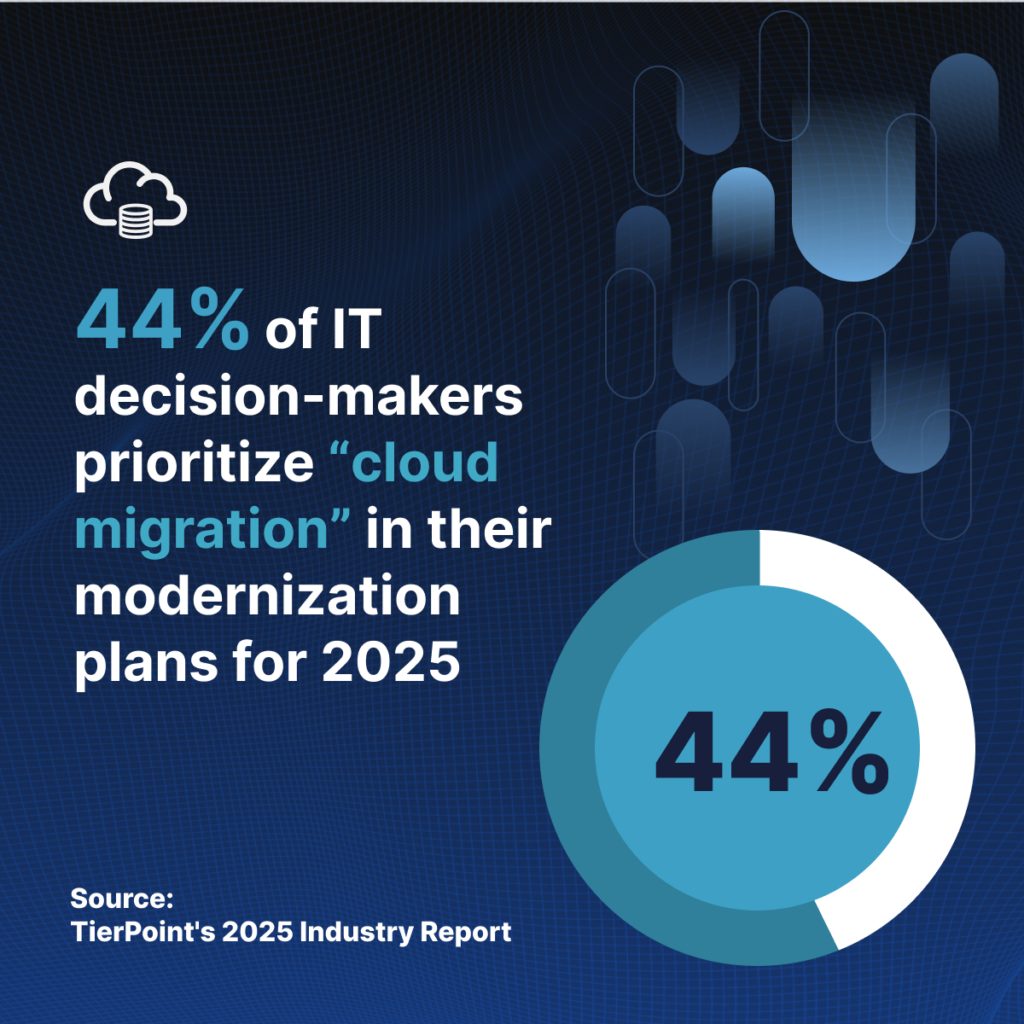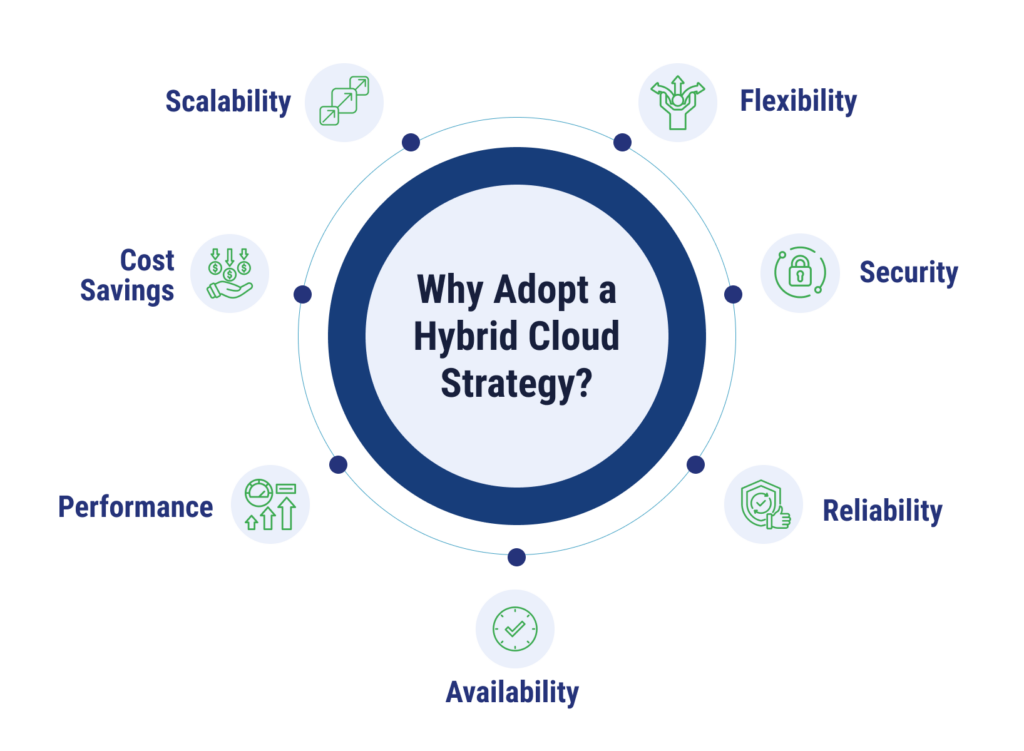
As businesses look to hybrid cloud adoption solutions to modernize their IT environments, there is a delicate balance in doing so both quickly and effectively. Adopting the cloud comes with benefits like cost savings and opportunities for digital innovation, but making the change doesn’t happen at the press of a button.
Even if you have the talent to manage an IT environment, it’s another thing entirely to manage hybrid cloud environments, conduct a cloud migration, and execute a cohesive hybrid cloud strategy. How can you speed up hybrid cloud adoption without running into snags? We’ll divulge the secret to hybrid cloud adoption.

What is Hybrid Cloud Infrastructure?
Hybrid cloud computing unifies public and private cloud environments, enhancing scalability, security, and flexibility. Proper implementation ensures seamless connectivity, centralized resource management, and improved disaster recovery through replication and resource allocation. It also boosts performance by offloading workloads during peak periods and allows regulatory compliance by keeping certain workloads on-premises.
Benefits of Hybrid Cloud Adoption
Businesses that successfully adopt hybrid cloud can benefit from greater flexibility, scalability, cost-efficiency, security, performance, and reliability.

Flexibility and Scalability
Whether it’s scaling up during times of demand or decreasing resources in quiet periods, hybrid cloud allows organizations to allocate their resources as needed. Workloads can be deployed in an optimal way that leverages the benefits of both public and private cloud features. Because businesses can be nimbler in hybrid environments, they can also accelerate their time-to-market, innovating new applications and services more quickly.
Cost Efficiency
Hybrid allows companies to leverage public cloud for variable or seasonal workloads, paying only for what they use while keeping predictable, steady-state workloads/apps in a private or on-premises environment, where costs can be more predictable. This balance helps avoid overprovisioning infrastructure, reduces waste, and ensures businesses get the best value for their investments.
Also, hybrid environments make it easier to modernize legacy apps incrementally, avoiding the large upfront costs of a full migration while benefiting from the scalability and innovation of the cloud.
Enhanced Security
The key benefit of hybrid is the ability to keep sensitive or regulated data in secure, private environment with full control. This allows companies to implement robust security protocols, including network segmentation, data encryption, and compliance monitoring, tailored to individual workloads.
Hybrid cloud solutions often integrate advanced security tools, such as threat detection and automated patching, allowing businesses to maintain a proactive and resilient security posture.
Reliability and High Availability
Companies can replicate critical data and apps across both public and private environments, ensuring high availability and quick recovery in the event of an outage/cyberattack/disaster. With the ability to backup sensitive data to a secure, private server while utilizing the scale and the georedundancy of public cloud platforms for rapid failover, companies can minimize downtime and protect operations. Maybe also mention that data and apps can be replicated across multiple geographically dispersed regions in the public cloud.
Key Considerations for Adopting a Hybrid Cloud Strategy
If you think adopting a hybrid cloud strategy is right for your organization, it’s important to consider what data integration, compliance, security, and cloud complexity will look like in this new environment.
Data Integration and Management
Data consistency across multiple environments can be more challenging than managing just one environment. It can also be time-consuming to migrate large datasets between private and public clouds without a well-defined strategy.
Businesses need to carefully plan how they will protect sensitive data in public and private cloud environments—where will different datasets be kept, and what can be done to ensure reliable protection? Strategies and tools for data synchronization, data transformation, and accessibility are needed to enable applications to access the right data at the right time, regardless of location. Data governance policies are also critical to ensure compliance with regulations and maintain security across environments.
Compliance and Regulatory Concerns
Some businesses may be subject to data residency laws. These regulations outline where data must be physically stored and processed, and it can become more difficult to adhere to when data may be stored and processed in multiple jurisdictions. Hybrid cloud strategies can also become limited in their flexibility if regulations require data to be stored and processed within specific geographic boundaries.
When dealing with multiple cloud providers, in the case of a more complex hybrid cloud, it can be tricky for businesses to meet standards like GDPR, PCI DSS, and HIPAA. The more environments get added, the more businesses need to work to maintain comprehensive compliance.
Security Risks
While hybrid clouds can often be more secure than on-premises environments, proper implementation of security measures—and how those security practices are managed and maintained—is key. A hybrid cloud environment has a larger attack surface compared to on-premises environments, which can open a business up to a wider range of possible threats. If something is improperly configured, organizations can be more exposed to security vulnerabilities and potential data breaches.
Businesses adopting a hybrid cloud strategy need to be familiar with and care for the shared responsibility model from public cloud providers and understand those boundaries to avoid gaps. It is also necessary to encrypt data in transit and secure network connections, as moving data between hybrid environments is vulnerable to interception.
Managing security across both environments can create blind spots, so a unified monitoring and logging solution is needed to detect threats and maintain visibility. Hybrid also increases the complexity of identity and access management, making it important to establish role-based access control, least-privilege principles, and strong authentication.
Complexity of Managing Hybrid Environments
The team working in a hybrid cloud environment needs to be more well-versed in the complexity that comes with these architectures. They need to have expertise in both cloud-native technologies and traditional IT systems with an understanding of how the two work together. Your organization also needs to use orchestration and automation tools to effectively manage the hybrid cloud environment while considering how to optimize costs.
Best Practices for a Successful Hybrid Cloud Strategy
After looking at the current state of your IT environment, it’s time to figure out the best pathway to success. Here are some of the best practices your business should ensure are implemented for a successful hybrid cloud strategy.
Clear Deployment Strategies
The process to a clear deployment strategy would look something like this: Start with understanding your business goals and outcomes. Then, survey your entire IT environment to understand your current infrastructure.
After examining your workload needs, it’s time to identify the right cloud platforms for each one. Depending on what you find, the options can vary. You may want to implement private cloud, multitenant, on-premises infrastructure, or public cloud deployments.
Then it’s time to plan the migration of workloads to the cloud, which should take into consideration factors such as data migration, application modernization, and hybrid network connectivity. Consider a phased approach, starting with less critical workloads to gain confidence before scaling to more complex systems, ensuring a controlled, risk-managed transition to hybrid cloud.
Efficient Data Management
To ensure data is consistent, compliant, and secure, businesses must establish clear governance policies and procedures; this includes defining clear roles, access controls, and compliance checks to safeguard sensitive data. It’s also important to set up hybrid backup and recovery strategies tailored to each cloud environment with automation in place to minimize risks associated with data loss and downtime.
Not all data needs to be stored forever, so organizations should also create a data lifecycle policy that optimizes storage costs by tiering data, while implementing safeguards to avoid accidental deletion of critical information.
Ensuring Security and Compliance
Managing security requirements across multiple cloud environments can introduce more risks. Those multiple environments also need to meet your regulatory and compliance requirements. Security teams need to account for this added complexity and may need to supplement internal security with outside expertise when implementing best practices and frameworks.
Some security measures that might be added include network security measures, identity and access controls, and compliance frameworks that adhere to specific industry standards. Security teams should also conduct regular assessments to find and reduce risks from potential vulnerabilities.
Regular Monitoring and Optimization
Hybrid cloud adoption isn’t a standalone project. To be done successfully, businesses need to regularly monitor and optimize the environment for performance issues, cloud costs, capacity planning, and security issues. Monitoring tools should provide unified visibility across both public and private clouds, allowing teams to track resource usage, application performance, and security events in real-time. Security teams also need to have a well-defined incident response plan in place.
Tools and Technologies Supporting Hybrid Cloud
The tools your organization used for on-premises environments may not be appropriate for a new hybrid cloud configuration. Here are a few tools and technologies you may want to incorporate to support your hybrid cloud environment.
Cloud Management Platforms
Whether you are operating in hybrid cloud or multicloud environment, cloud management platforms can be a valuable extension of your team. Azure Arc, for example, provides a consistent, secure operational model for managing infrastructures across AWS, Google Cloud, VMware, and on-premises environments. Here’s how it works:
- Reach: Manage Windows and Linux environments on VMs or bare metal with a scalable, searchable inventory for streamlined infrastructure management.
- Configure: Standardize configurations with consistent VM extensions and centralized agent management for monitoring, security, and updates.
- Govern: Enforce compliance with built-in Azure Policies, auditing and maintaining system settings to meet corporate and regulatory standards.
- Secure: Enhance security with Entra ID Managed Identity, server security baselines, and role-based access control.
Security Solutions
Using native security tools from Microsoft or AWS for hybrid cloud setups offers several advantages over third-party tools, especially in environments where consistency, integration, and cost-efficiency are key considerations. Native tools are designed specifically for their ecosystems (Azure or AWS), ensuring deep integration with services, applications, and workloads. They also often provide better compatibility with the cloud provider’s APIs, simplifying configuration and management. Consider the following security tool options for your setup.
- Azure Sentinel: A cloud-native SIEM (Security Information and Event Management) and SOAR (Security Orchestration, Automation, and Response) solution, Azure Sentinel collects and analyzes data from on-premises and cloud environments to detect and respond to threats.
- Azure Arc-Enabled Security Features: By extending Azure Security Center capabilities to non-Azure resources, this tool brings Azure Policy and Defender for Cloud to hybrid and multicloud setups for consistent security governance.
- Microsoft Defender for Identity: This option protects hybrid identity infrastructure by monitoring Active Directory on-premises and Azure Active Directory. It also identifies suspicious activities, compromised accounts, and insider threats.
Monitoring and Analytics Tools
Real-time insights and data presented by advanced analytics tools can help organizations make strategic decisions more quickly.
- Datadog offers a unified view of application and infrastructure performance across on-premises and cloud platforms, offering real-time alerts and detailed observability.
- Splunk can analyze logs, events, and metrics from diverse sources, creating actionable insights into system behavior and security.
- New Relic focuses on application performance monitoring (APM), helping to identify and resolve performance bottlenecks in hybrid or multicloud environments.
Together, these tools can empower businesses to maintain reliability, optimize performance, and address issues proactively in complex, distributed infrastructures.
Future Trends in Hybrid Cloud Solutions
What’s next for hybrid cloud solutions, and how can you stay ahead of the pack? Cloud technologies will continue to evolve, automation will get more sophisticated, and edge computing will keep growing, so here’s what you need to know to stay current.
The Evolution of Cloud Technologies
Hybrid cloud is already extremely popular. According to Flexera’s 2024 State of the Cloud report, 89% of organizations have embraced a multicloud model, with 73% using hybrid cloud. We expect this number to continue to grow as businesses look to optimize their workloads.
Cloud technologies will also expand with quantum computing, a technique that uses quantum mechanics to perform calculations much faster than traditional computing. This will accelerate data processing further.
Increased Automation and AI Integration
Resource allocation and routine tasks can be made more efficient through artificial intelligence (AI), which can help with automation and resource optimization. AI can also predict future resource needs and address potential issues early using predictive analytics. AI-powered solutions can also detect and respond to threats faster than humans when trained effectively.
Growth of Edge Computing in Hybrid Clouds
Edge computing allows applications to process data closer to the source, allowing for real-time responses and improved user experiences. Not only can this reduce latency, but it can also improve data security by minimizing the volume of raw data transmitted to the cloud.
Need Help with Your Hybrid Cloud Adoption Strategy?
The secret to successful adoption, deployment, and cloud management is not as complicated as you think—it all comes down to bringing in the right qualified people. Most businesses can be more successful with hybrid cloud deployments by relying on expertise from a managed services cloud provider. Learn more about TierPoint and how we can help you with your hybrid cloud strategy today.

